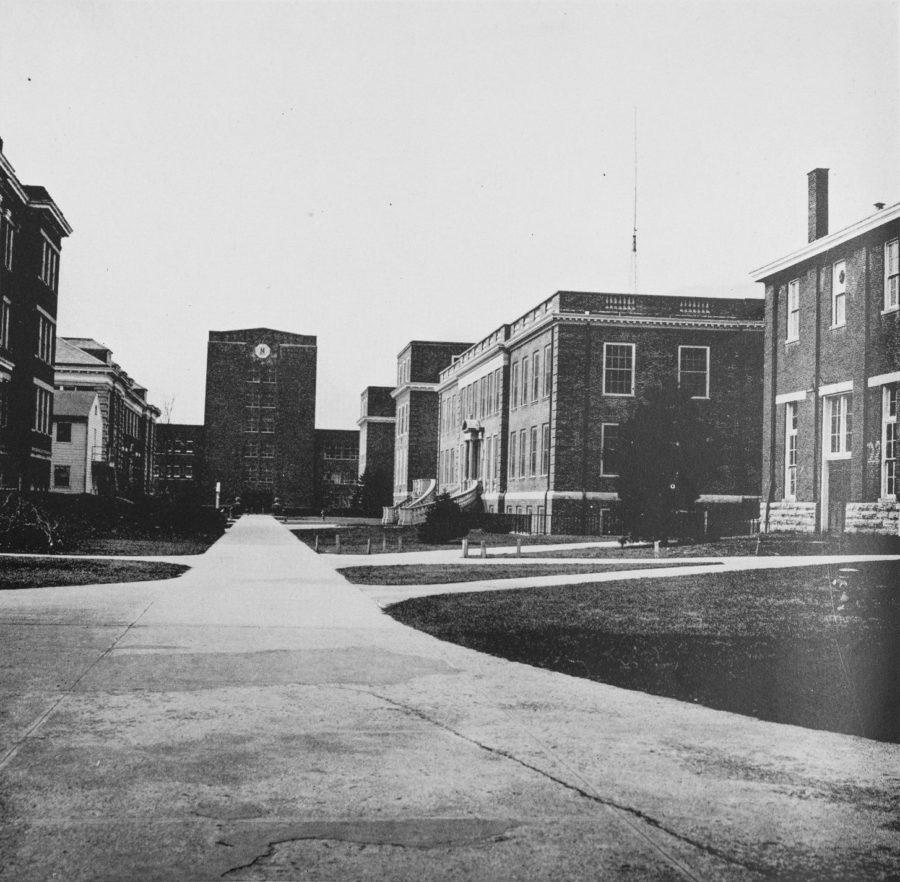Review of Kentuckian yearbooks reveals photos of students in blackface
September 27, 2019
Editor’s note: Photos farther down in this article may be offensive. A version without the photos can be found here.
In 1959, UK students were fresh off a National Championship basketball season, they went to the Student Union for lunch, frequented Keeneland for the races and even watched as the Wildcats “thrashed” Mississippi State’s football team 33-12 on Homecoming weekend. You could say it was a good year.
The Kentuckian yearbook commemorated good times at the University of Kentucky for more than a century, but some of them also contain unsettling images of UK students — pictures of them donning blackface and Ku Klux Klan robes.
A review of dozens of archived Kentuckian yearbooks revealed that photos of UK students publicly engaging in racially insensitive behavior were published yearly for most of the 1950s.
The Kernel found at least one instance of students wearing blackface in the 1952, and 1954-1960 yearbooks.
An earlier investigation conducted by the USA TODAY Network concluded that no such pictures existed in UK yearbooks during the years 1930-1942, 1944-45, 1947, 1949-51, 1953, 1962-1966, 1972-73, 1968-69 and 1986.
The Kentuckian was UK’s perennial yearbook established in 1906 and published annually until 2014. The Kernel and the Kentuckian were both previously overseen by the Board of Student Publications, but were both editorially separate.
Copies of archived Kentuckian yearbooks can be accessed at the UK Libraries. The Kernel also owns multiple published copies of the Kentuckian.
English professor Gurney Norman, who was the editor of the 1959 edition of the Kentuckian during his senior year at UK, said it’s important to review these pictures in the context of their era.
“The pictures don’t begin to indicate the rampant level of racism that prevailed in the country and in Kentucky and at UK, in as late as 1960,” said Norman. “It was a white world, as far as official institutions were concerned. It was not unusual that someone would wear blackface as a joke.”
Norman also worked on the Kentuckian’s staff in 1957 and 1958.
UK Historian Dr. Terry Birdwhistell echoed Norman’s sentiments about the campus’s racial climate in the 1950’s.
“Considering the climate at the time, the band still played ‘Dixie’ up through the mid to late 1960’s. I think there was a lack of consciousness and sensitivity to issues of race on campus,” Birdwhistell said.
Dr. George Wright is a visiting professor of history stationed at UK in honor of the university’s 70th anniversary of integration. He said that instances of blackface were not confined to UK.
“It’s not just the University of Kentucky. What we’re talking about is not necessarily a southern phenomenon but a national phenomenon,” said Wright. “Tragically, if you could just point the finger at Kentucky, or Ole Miss, or Alabama I think we would do that, but you can point the finger at any university.”
Wright also raised his own questions about the campus’s racial climate during the 1950’s.
“I guess the question for me is what does it say about the world we lived, when in a time when we know it’s not appropriate to make fun of, to ridicule, to demean most people and most things, it was okay to do with black people. Why was that the case,” said Wright.
But however painful these images may be, Norman said the unearthing of these “ancient” images should serve as a challenge to all of the UK community to further the dialogue about social issues on campus.
“In a way, it’s good that someone of the 20 journalism majors helping to put the yearbook together…included those images, because it’s always relevant when anything has us talk about race in American culture,” Norman said. “To me it’s more than just a casual notice of imagery in an ancient book. To notice this now needs to be part of the ongoing discourse in the country about social justice in all of its forms.”
Birdwhistell noted that the campus’s increased attention to issues of race can be seen in the content we find in later editions of the Kentuckian.
“I think the thing we can be proud of is that if you look at the Kentuckian in the late 1960’s and 1970’s, you just see a complete change in the representation of African Americans in the yearbook, and the sensitivity to racial issues, and the yearbook taking on really hard issues in the Kentuckian,” said Birdwhistell.
This year marks UK’s 70th anniversary of integration. Wright said that this is a prime time to address issues like race and diversity on campus.
“We all have the potential to grow into change, but we can’t if we don’t address these things, and I think that’s what’s important,” said Wright.































































































































































